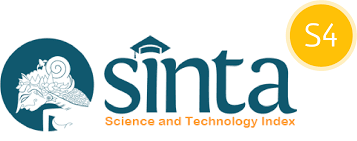Deteksi Kecacatan Permukaan Rel Menggunakan Metode Deep Learning Neural Network
DOI:
https://doi.org/10.29408/jit.v6i1.7415Keywords:
Disability Detection, Railways, Deep Learning Neural NetworksAbstract
Rail is a construction in one unit made of steel, concrete, and other construction materials above or below the ground depending on the direction and area. The condition of the rail surface must not have any defects so that train travel is safe and comfortable. This research method discusses the research design. There are four processes in this research design, namely the data acquisition process, the RGB image color conversion process to HSI, the filtering process using the gabor filter, and the classification process using deep learning neural networks. The purpose of this study is to build a system to visually detect defects in the surface of the railroad tracks, namely image processing techniques. This activity was carried out at the Madiun Indonesian Railways Polytechnic Station Laboratory. Based on the research that has been done, it can be concluded that an image with a size of 32x32 pixels produces the highest accuracy value at epoch 90 using the gabor filter image type. The more epochs used, the better the results will be and the better the model can be made. The accuracy results obtained were 0.8041 or 80.41% for training accuracy and testing accuracy of 0.79 or 79%References
Permenhub, “Peraturan Menteri Perhubungan Republik Indonesia Nomor 18 Tahun 2020 tentang Pengendalian Transportasi Dalam Rangka Pencegahan Penyebaran Coronavirus Disease 2019 (COVID-19),” vol. Nomor 9, no. Pedoman Pembatasan Sosial Berskala Besar dalam Rangka Percepatan Penanganan Corona Virus DIsease 2019 (COVID-19). Jakarta, pp. 1–71, 2020.
Budionoa and Suwarsono, “Inspection on Rail Quality by using Image Processing Method,” J. Energy, Mech. Mater. Manuf. Eng., vol. 4, no. 2, pp. 111–118, 2019.
Suwarsono, Budiono, K. Hadi, E. Satiawan, and M. Prabaswara4, “Karakterisasi dan modifikasi pembakaran sekunder pada kompor biomassa rendah emisi,” Semin. Nas. Teknol. dan Rekayasa, no. 2017, pp. 61–64, 2018.
X. Zhou, P. Lu, Z. Zheng, D. Tolliver, and A. Keramati, “Accident Prediction Accuracy Assessment for Highway-Rail Grade Crossings Using Random Forest Algorithm Compared with Decision Tree,” Reliab. Eng. Syst. Saf., 2020, doi: 10.1016/j.ress.2020.106931.
H. Cho, H. J. Yoon, and J. Y. Jung, “Image-Based Crack Detection Using Crack Width Transform (CWT) Algorithm,” IEEE Access, 2018, doi: 10.1109/ACCESS.2018.2875889.
R. Thendral and A. Ranjeeth, “Computer vision system for railway track crack detection using deep learning neural network,” 2021. doi: 10.1109/ICSPC51351.2021.9451771.
T. Hadi, S. Sugiharto, S. Supriyo, and ..., “Rancang Bangun Komponen Pendorong Alat Pasang Pendrol Untuk Uji Penambat Rel,” Bangun Rekaprima …, vol. 04, pp. 36–44, 2018.
H. Edha, S. H. Sitorus, and U. Ristian, “PENERAPAN METODE TRANSFORMASI RUANG WARNA HUE SATURATION INTENSITY (HSI) UNTUK MENDETEKSI KEMATANGAN BUAH MANGGA HARUM MANIS Hendryanto,” J. Komput. dan Apl., vol. 8, no. 1, pp. 1–10, 2020.
Prasetyo and Eko, Data mining mengolah data menjadi informasi menggunakan matlab. Yogyakarta: Penerbit Andi, 2019.
Lubis and D. Darmawan, “Perbandingan Metode Contrast Stretching Dan Metode Retinex Untuk Peningkatan Citra Digital,” Universitas Islam Negeri Sumatera Utara Medan, 2021.
Primartha, Belajar Machine Learning Teori dan Praktik. Bandung: Penerbit Informatika, 2018.
A. Peryanto, A. Yudhana, and R. Umar, “Rancang Bangun Klasifikasi Citra Dengan Teknologi Deep Learning Berbasis Metode Convolutional Neural Network,” Format J. Ilm. Tek. Inform., 2020, doi: 10.22441/format.2019.v8.i2.007.
A. Santoso and G. Ariyanto, “Implementasi Deep Learning berbasis Keras untuk Pengenalan Wajah,” Emit. J. Tek. Elektro, 2018, doi: 10.23917/emitor.v18i01.6235.
P. A. Nugroho, I. Fenriana, and R. Arijanto, “Implementasi Deep Learning Menggunakan Convolutional Neural Network ( Cnn ) Pada Ekspresi Manusia,” Algor, vol. 2, no. 1, pp. 12–21, 2020.
H. Abhirawa, M. S. Jondri, and A. Arifianto, “Pengenalan Wajah Menggunakan Convolutional Neural Network Face Recognition Using Convolutional Neural Network,” e-Proceeding Eng., vol. 4, no. 3, pp. 4907–4916, 2017.
Suwarsono, “Railroad Surface Defect Inspection Using Parallel Lines Laser,” Pros. SENTRA (Seminar Teknol. dan Rekayasa), vol. 4, 2019.
A. R. Putri, “PENGOLAHAN CITRA DENGAN MENGGUNAKAN WEB CAM PADA KENDARAAN BERGERAK DI JALAN RAYA,” JIPI (Jurnal Ilm. Penelit. dan Pembelajaran Inform., 2016, doi: 10.29100/jipi.v1i01.18.
N. Afiyat, “ANALISIS RESTORASI CITRA KABUR ALGORITMA WIENER MENGGUNAKAN INDEKS KUALITAS CITRA,” NJCA (Nusantara J. Comput. Its Appl., 2017, doi: 10.36564/njca.v2i1.27.
M. Wasil, H. Harianto, and F. Fathurrahman, “Pengaruh epoch pada akurasi menggunakan convolutional neural network untuk klasifikasi fashion dan furniture,” Info J. Inform. dan Teknol., vol. 5, no. 1, pp. 53–61, 2022.
A. M. Nur and F. Farhurrahman, “Identifikasi Kematangan Buah Mentimun Berbasis Citra Digital Menggunakan Jaringan Syaraf Tiruan Backpropagation,” Infotek J. Inform. dan Teknol., vol. 2, no. 1, pp. 27–33, 2019.
Downloads
Published
How to Cite
Issue
Section
License
Semua tulisan pada jurnal ini menjadi tanggung jawab penuh penulis. Jurnal Infotek memberikan akses terbuka terhadap siapapun agar informasi dan temuan pada artikel tersebut bermanfaat bagi semua orang. Jurnal Infotek ini dapat diakses dan diunduh secara gratis, tanpa dipungut biaya sesuai dengan lisense creative commons yang digunakan.
Jurnal Infotek is licensed under a Creative Commons Attribution 4.0 International License.
Statistik Pengunjung




